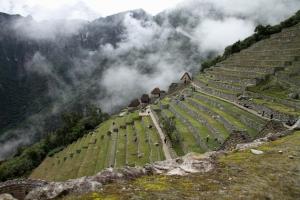The School of Athens by Raphael Sanzio: analysis and meaning
The School of Athens It is a fresco by Raphael Sanzio made between 1510-1511. It is located in the Estancia del Seal o Stanza della Segnatura —A room destined to be the papal library in the Apostolic Palace of the Vatican.
It is part of the "Vatican Rooms", a set of four rooms in the Palace, whose decoration was commissioned by Pope Julius II to various artists, although these were eventually replaced by Rafael. That is why today these rooms are also known as “Rafael's Rooms”.
The School of Athens represents the value of scientific thought and natural truth, whose development is attributed to classical antiquity. The work embodies the entire cultural program of the Renaissance, as we see the presence of the great thinkers and scientists of the classical world, and even the Renaissance itself.
Analysis of The School of Athens by Rafael Sanzio
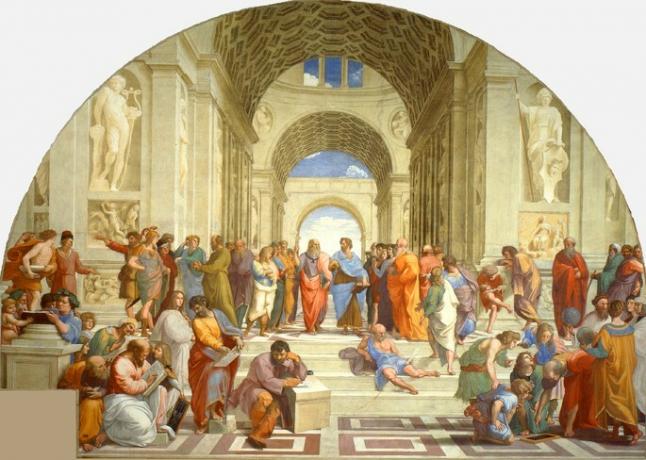
The School of Athens It is a fresco painting that has a base 7.7 meters wide and reaches a maximum height of 5 meters at the end of the arch. Constructed from linear or vanishing point perspective, the scene is framed in a severe architectural space.
Rafael took advantage of the technique of painted architecture to create a greater sense of depth, just as he had learned from Perugino.
He did not look for constructive references in the Greek world but in the Roman one, particularly in the work of Bramante. This architect had been in charge of the project for the renovation of the Basilica of San Pedro, of Paleo-Christian aesthetics.
Scene description
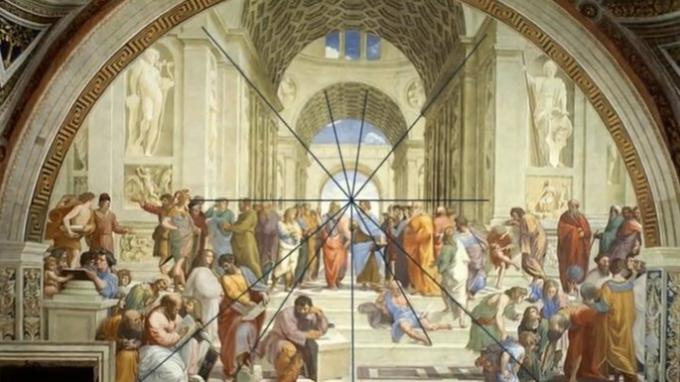
As a setting, Rafael represents three successive barrel vaults, formed by semicircular arches, whose open bottoms and suggested separations create a greater sense of depth. On the sides of these vaults, we see a gallery of columns and statues, an allegorical reference to Greco-Latin culture.
Two sculptural figures flank the scene and dominate it in the upper half. They are Apollo, symbol of order, harmony and reason, and Athena, symbol of wisdom, the arts and war strategy.
On this stage, we see the representation of various historical figures from the fields of philosophy, mathematics, science, the arts and politics. They coexist with the extemporaneous presence of some figures from the Renaissance period, including Raphael himself.
The most important characters are the two figures in the center of the composition, which we can easily locate by the clear and diaphanous sky that opens behind their heads. They are the philosophers Plato and Aristotle, indisputable protagonists of the scene.
Characters of The school of Athens
The School of Athens it has many characters. So far, not all of them have been identified, although most have been. As if that were not enough, some attributions made to date are doubtful, so that there are different hypotheses.
In several cases, Rafael used contemporary personalities as physical referents. Next we will see which are the characters represented and their attributes or symbols. Those who are subject to doubt will be identified in due course.
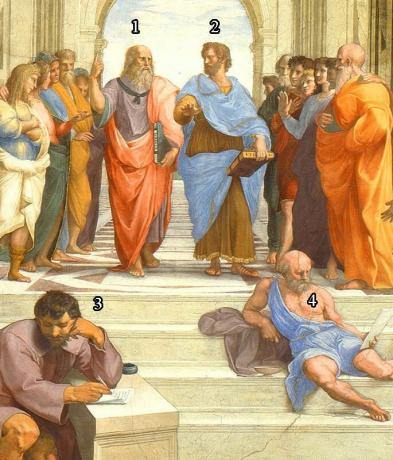
1. Plato. Plato, who has been represented with the features of the master Leonardo da Vinci, holds the book Timaeus. His finger points to the sky. This gesture refers to the Theory of Ideas that bases his line of thought.
2. Aristotle. To the right of Plato, we see Aristotle holding the book Ethics. His right hand, at waist height, keeps the palm parallel to the ground. With this, Rafael alludes to Aristotle's theory of forms, who thought that things are in themselves and that they do not exist as dual reality (body and soul separation).
3. Heraclitus (as Michelangelo). Philosopher, represented as Michelangelo both in features and attire and, in turn, on a marble base.
4. Diogenes. Thinker of the cynical school, famous for his lack of interest in social uses and customs, to which he contrasted the principle of autonomy.
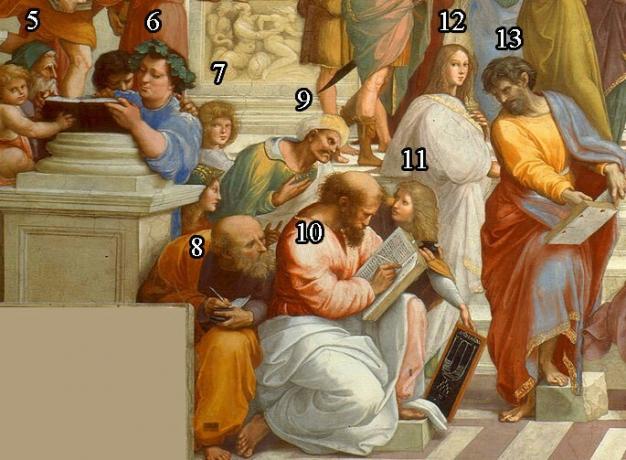
5. Zeno of Elea: He was a Greek philosopher disciple of Parmenides, representative of the Eleatic school.
6. Epicurus. He was the creator of Epicureanism which, among other things, denied the immortality of the soul and defended hedonism.
7. Federico Gonzaga. Federico Gonzaga was then the Duke of Mantua, by appointment of Leo X. He was an important patron.
8. Anaximander (?). This character could be Anaximander, disciple of Thales of Miletus, he was known as a philosopher and geographer. The names of Severino Boezio, Aristosseno, Senocrate and Empedocle have also been suggested.
9. Averroes. Averroes was an Andalusian philosopher, mathematician and physician of the Middle Ages (12th century), who also taught Islamic laws.
10. Pythagoras. Greek philosopher and mathematician. In addition to a book, in front of him we see a blackboard that shows the numerical triangle "Tetraktys", symbol of the unity of the universe, and we also see the symbol of the theory of musical harmony.
11. Telange: Disciple of Pythagoras, in charge of holding the blackboard for him.
12. Hypatia of Alexandria. Neoplatonic philosopher and professor, known for her contributions in mathematics, astronomy, algebra, and geometry.
13. Parmenides. Philosopher, precursor of Platonic idealism and founder of the Eleatic school.
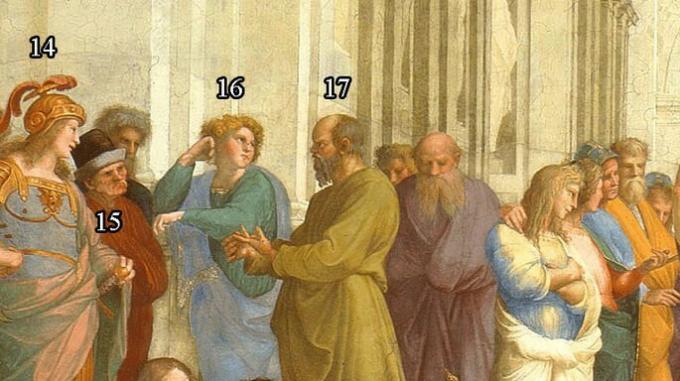
14. Alexander the Great. King of Macedonia, who defeated the Persians and extended his empire to Greece, Egypt to India. Alexander Magnno became a disciple of Aristotle.
15. Xenophon or Antisthenes. Xenophon was a historian, philosopher, and military man. One of his most important works is Hellenic, on the Peloponnesian War. It could also be Antisthenes, founder of the Cynical school in Greek antiquity.
16. Alcibiades. Some researchers propose that this figure could be a character from Plato's Banquet called Alcibiades, because he is in dialogue with Socrates.
17. Socrates. He is considered the father of Greek philosophical thought and the promoter of dialectics. He was Plato's teacher.

18. Plotinus: Neoplatonic philosopher, whose theory of the trinity and the One has been a source of inspiration for Christian philosophy. The model of reference is believed to be Pope Julius II.
19. Homer. Homer is the author to whom the composition of The Iliad and of The odyssey, fundamental literary works of Greek culture.
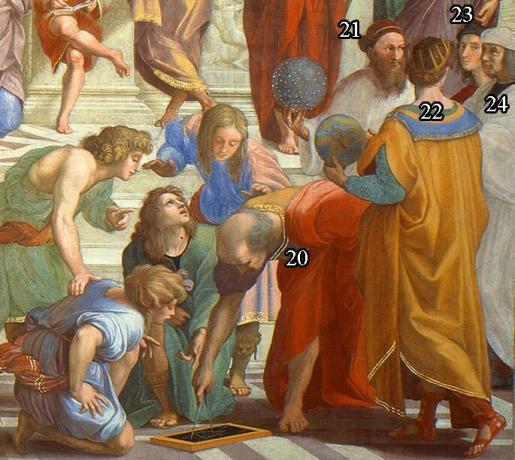
20. Euclid or Archimedes (as Bramante). It is not known for sure who this figure represents, but judging by the use of the compass, it may be Euclid or Archimedes. The face is that of Leonardo Bramante, architect of the Renaissance.
21. Ptolemy. Astronomer, geographer, mathematician and chemist of the transition between the 1st century and the 2nd century c. C, of Greek-Egyptian origin. The character is holding a globe.
22. Apelles (as Rafael Sanzio). Clearly, this figure is a self-portrait of Raphael Sanzio, but he embodies the character of Apelles, a painter of the Ancient Age. Normally, when this occurs in painting, the author looks directly at the audience, breaking the fiction.
23. Protógenes (like Sodom). Protógenes was another painter of the Old Age, rival of Apelles. Raphael portrays him as El Sodoma (nickname for Giovanni Antonio Bazzi), a contemporary painter whom Raphael replaced to commission the Estancia del Seal.
24. Zoroaster or Strabo. The character carries a celestial globe. The most widespread thesis maintains that it is about Zoroaster, a founding prophet of one of the first monotheistic religions, known as Mazdeism. Other researchers suggest that it is Strabo, a Greek geographer and historian.
The Athenian Academy, an institute founded by Plato
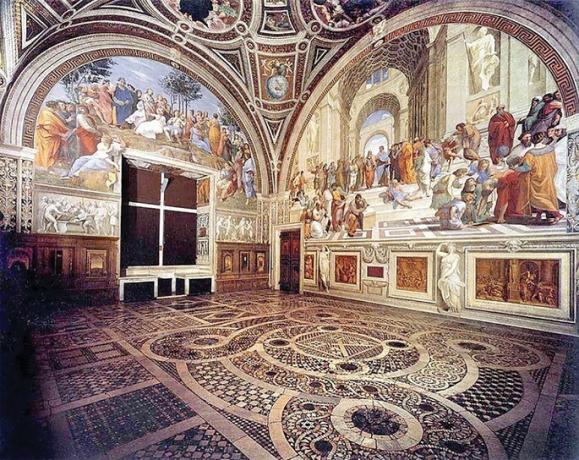
All these characters evoke in an idyllic way what was The Academy of Athens, in which Rafael found conceptual inspiration. The Academy of Athens was a school founded by Plato himself around the 4th century BC. C. for teaching philosophy, mathematics, astronomy, medicine, and rhetoric.
This academy, where personalities such as Aristotle received their training, was of such importance to the ancient world that its existence lasted until the 5th century AD. C., almost nine centuries. Its operation was not continuous for various reasons, but it certainly kept its validity in thought.
It may interest you:
- Rafael Sanzio: biography, contributions and works of the genius of the Renaissance.
- Renaissance: what is it, values, characteristics and most important works.
Meaning of fresco The School of Athens
The meaning of Raphael's fresco can be synthesized in the celebration of philosophy, mother of all sciences, as well as in the celebration of scientific thought and recognition of the contributions of thinkers (philosophers, mathematicians, geometricians, etc.) of the antiquity.
In keeping with this renewing spirit, Rafael wanted to create an idyllic academy that is, in turn, the memory of the greatness of the Academy of Athens, founded by Plato.
The researcher Giulio Carlo Argan comments that this work represents ancient wisdom. For this reason, the painter discards the representation of nature and focuses on personalities and architecture.
Architecture thus becomes, according to Argan, a symbol of the construction of human thought. And people, treated in a monumental way too, are the embodiment of this principle. Thus, Argan adds that this «... pretends to be a“ reborn ”building, in the same way that the wisdom of thinkers of antiquity have been "reborn" through thought and doctrine Christian ”.
Art as knowledge
Along with the assessment of philosophical and scientific thought, Raphael introduces one of the most original elements of the Renaissance compared to the predecessor Middle Ages.
We do not refer to the inclusion of artists in the work, either as a direct reference or as models. Rafael, like his contemporary colleagues, such as Leonardo, devoted himself to defending the dignity of the plastic arts as a form of knowledge.
By including the representation of Leonardo, Michelangelo, Bramante, El Sodoma and even himself, Rafael is subverting the ancient thought that condemned the plastic as a mere art mechanical.
In this way he raises it to the same level enjoyed by the liberal arts, which until then were grouped in the Quadrivium and the Trivium. The Quadrivium it included arithmetrics, geometry, astronomy, and music. The Trivium it included grammar, dialectics, and rhetoric.
Light as a metaphor for knowledge
Now why if Raphael wanted to revive Plato's Academy, was he inspired by the architectural form of Bramante's project for St. Peter's Basilica? This happened because, according to researchers Charles, Manca and McShane, Rafael wanted to give materiality to the ideal of the “Temple of Philosophy”, a thesis defended by the thinker Marsilio Ficino.
The authors Charles, Manca and McShane also state that the work is dominated by frank and diaphanous light. How do they interpret it? They interpret it as a metaphor for the path that leads to knowledge.
In conclusion, we can affirm that in this work by Rafael, human beings are the center of creative passion. They are the protagonists of the scene. They, with their knowledge and curiosity, they as "discoverers" of the mysteries of nature.
This is nothing more than an expression of a culture that finds in rational thought the foundation of civic values. The School of Athens by Rafael Sanzio is a compendium of anthropocentric humanism. If there is a work that summarizes the values and characteristics of the Italian Renaissance, that is The School of Athens.
It may interest you: The 25 most representative paintings of the Renaissance
References
- Argan, Giulio Carlo: Renaissance and Baroque (II. From Michelangelo to Tiepolo), Madrid: Akal Editions, 1999.
- Brisson, Luc: "Platonism" in VV. AA.: Akal Dictionary of Greek Lore, Madrid: Akal, 2000.
- Charles, Victoria, Joseph Manca and Megan McShane: 1000 Paintings of the Grand Masters, Mexico: Númen, 2006.

